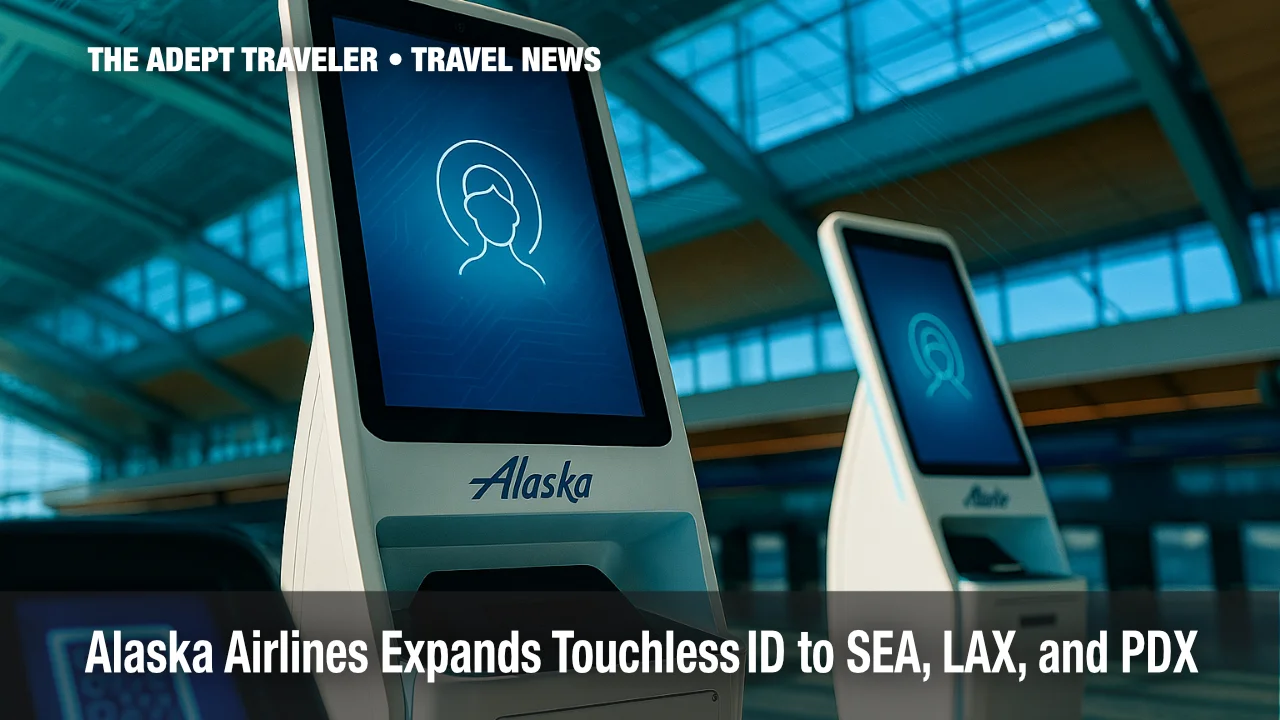Alaska Airlines Expands Touchless ID to Seattle, LAX, and Portland

Alaska Airlines is leveling up airport security once again. Beginning June 26, the carrier will roll out TSA PreCheck Touchless ID at Seattle Tacoma International Airport, followed by Los Angeles International on July 8 and Portland International on July 10. The program lets eligible travelers verify identity with a quick facial scan instead of handing over a passport or driver's license, trimming precious minutes from the checkpoint. For business and leisure flyers alike, Alaska Airlines is turning biometrics into everyday convenience.
Key Points
- Three new airports add the service between June 26 and July 10.
- Available to TSA PreCheck members who opt in via the Alaska app.
- Facial recognition replaces physical IDs at security podiums.
- Why it matters: Hands-free screening speeds peak-season lines.
- Expansion follows earlier launches in Atlanta and Washington National.
Alaska Airlines Touchless ID Snapshot
Seattle passengers will be the first to benefit when the airline activates Touchless ID in its hometown hub on June 26. Los Angeles follows less than two weeks later, while Portland turns on the system July 10. Travelers who have TSA PreCheck, a valid passport stored in their Mileage Plan profile, and who opt in during check-in will see a "Touchless ID" lane icon on their mobile boarding pass. Instead of showing identification, they pause at a camera; the system confirms a match, displays an "OK" to the officer, and they head straight to the X-ray.
Momentum Behind Biometric Security
The Transportation Security Administration has tested digital identity since 2022, and airlines from Delta to United have adopted versions at select checkpoints. Alaska Airlines was an early advocate, using Atlanta and Washington National to prove reliability and privacy controls. Passenger uptake exceeded 70 percent at those airports this spring, persuading both TSA and Alaska to prioritize expansion into the carrier's West Coast hubs. With Seattle Tacoma International Airport logging more than 50 million annual passengers, widespread use could cut thousands of physical ID checks per day.
How Touchless ID Arrives at Seattle, LAX, and Portland
Alaska Airlines and TSA engineers completed site surveys in April to install hardware where PreCheck lanes intersect the airline's busiest concourses. At Seattle Tacoma International Airport, the technology debuts in Checkpoint 5, closest to Alaska's primary gates. Los Angeles International will equip Terminal 6, while Portland International positions scanners in the Concourse B checkpoint. Software updates hit the Alaska mobile app this week, letting Mileage Plan members store an encrypted passport image secured by multi-factor login.
During check-in, eligible travelers toggle "Use Touchless ID." A unique token-never the actual face image-moves to TSA's system for a few minutes, long enough to validate identity when the traveler steps to the podium. Officers still monitor every verification on a screen and may request a physical ID at random. Alaska Airlines highlights that photos are deleted within 24 hours and are not used for law-enforcement databases. Flyers who prefer old-school screening simply leave the toggle off and proceed with a license or passport.
Early trials in Atlanta shaved a consistent 30-40 seconds per passenger. While that may sound modest, multiplying by several hundred people per hour relieves queue pressure during morning peaks. Alaska Airlines hopes to repeat those gains as Seattle's busy summer travel season ramps up, especially on popular routes to Hawaii and Alaska. The airline has hinted that San Francisco and San Diego could be next if West Coast adoption mirrors East Coast success.
Internally, the carrier ties biometrics to a broader "seamless journey" vision that already includes electronic bag tags and self-service bag drops. Executives say the eventual goal is curb-to-gate movement with minimal queuing and zero paper. TSA officials, meanwhile, see Touchless ID as a stepping-stone toward nationwide digital credentials if congressional funding materializes.
Analysis
For travelers, the immediate benefit is fewer fumbling moments at security. Business flyers racing to a morning meeting gain back the minute they usually spend digging for a wallet. Families with children can keep passports tucked away, lowering the risk of loss. Seattle Tacoma International Airport in particular struggles with early-morning congestion; shifting even half of Alaska's PreCheck users to facial scans should help lines move steadily. Privacy skeptics will note that Alaska Airlines has taken the extra step of deleting biometric images quickly and letting customers opt out without penalty, which may ease concerns. Still, broad adoption hinges on more airlines and airports joining, because nobody wants a patchwork where Touchless ID works on the outbound leg but not the return. If federal Real ID requirements slip again, programs like this could emerge as a faster de-facto standard.
Final Thoughts
Alaska Airlines is betting that small time savings add up to a smoother airport experience. Enrolling for TSA PreCheck and uploading a passport now will let West Coast travelers test Touchless ID as soon as next week. Pack a passport photo page on your phone as backup, arrive ten minutes early the first time, and watch the green "OK" light flash you through. With biometrics growing in retail, banking, and now aviation, Alaska Airlines is positioning itself at the forefront of a touch-free future.
